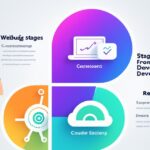Table of Contents
Search engine optimization (SEO) is crucial for improving website visibility and ranking in search engine results pages (SERPs). When it comes to frontend development, it’s essential to integrate SEO best practices to achieve optimal results. By implementing effective SEO strategies and techniques, developers can enhance a website’s visibility, search engine rankings, and user experience.
In this article, we will explore key aspects of SEO for frontend development, including keyword research, title tags, meta descriptions, header tags, content optimization, internal linking, and site structure. By understanding and implementing these techniques, developers can create websites that attract organic traffic and achieve business goals.
Let’s dive into the world of frontend SEO and discover how it can elevate your website’s performance.
SEO Keyword Research and Selection
Keyword research and selection are foundational steps in SEO for frontend development. This process involves identifying and selecting the most relevant and high-value keywords for a website or webpage. By conducting thorough keyword research, developers can optimize their websites to attract targeted organic traffic and improve search engine rankings.
To start the keyword research process, various tools such as Google Keyword Planner, SEMrush, Ahrefs, and Moz Keyword Explorer can be utilized to gather valuable insights. These tools provide data on keyword search volume, competition level, and relevance, enabling developers to make informed decisions.
When selecting keywords, it is crucial to consider user intent and the webpage’s content. The chosen keywords should align with what users are searching for and reflect the topics covered on the webpage. This ensures that the website will provide the desired information to users and satisfy their search intent.
One effective strategy is to use long-tail keywords, which are longer and more specific search phrases. Long-tail keywords have less competition and a higher chance of attracting relevant traffic. By incorporating long-tail keywords into the website’s content, developers can target niche audiences and improve website visibility in search engine results pages (SERPs).
However, it is important to avoid keyword stuffing or over-optimization, which is the excessive use of keywords in an unnatural manner. Search engines penalize websites that engage in keyword stuffing, as it detracts from the user experience and undermines the credibility of the website.
By conducting comprehensive keyword research and selecting high-value, relevant keywords, developers can lay a strong foundation for frontend SEO and improve website visibility and ranking in SERPs.
| Benefits of Keyword Research and Selection | Best Practices for Keyword Selection |
|---|---|
|
|
Optimizing Title Tags and Meta Descriptions
Title tags and meta descriptions are crucial elements in SEO that provide information about a webpage to search engines and users in SERPs. When optimizing title tags, it is important to keep them concise, descriptive, and include the primary keyword. Each webpage should have a unique title tag that does not exceed 60 characters.
Meta descriptions, on the other hand, should be descriptive, include the primary keyword, and entice users to click on the webpage. By crafting compelling meta descriptions, website owners can improve the click-through rate (CTR) of their pages, which positively impacts website ranking in search engine result pages (SERPs).
Effective title tags and meta descriptions can significantly influence the visibility and performance of a website. They provide users with a snapshot of the content and purpose of a webpage, influencing their decision to click and visit the site. When optimizing these elements, it is crucial to consider the target audience and align the messaging with their needs and preferences.
“A well-optimized title tag and meta description can make the difference between a user clicking on your webpage or scrolling past it in search results.”
Taking the time to write compelling and relevant title tags and meta descriptions can have a direct impact on the CTR and overall website ranking. A high CTR indicates that users find the webpage appealing and relevant to their search query, leading to improved organic traffic and potential conversions.
Example of a well-optimized title tag:
<title>SEO-Friendly Title Tag - Boosting Website Visibility and CTR</title>
Example of a well-optimized meta description:
<meta name="description" content="Learn how to optimize your title tags and meta descriptions to improve your website's CTR, website ranking, and overall visibility in SERPs." />
| Title Tags | Meta Descriptions |
|---|---|
| Concise | Descriptive |
| Includes primary keyword | Includes primary keyword |
| Unique for each webpage | Entices users to click |
| Does not exceed 60 characters |
Enhancing Header Tags and Content Optimization
Header tags (H1, H2, H3, etc.) are essential for structuring webpage content and improving user experience. These tags help search engines and users understand the main topics and sections of a webpage. When optimizing header tags, it is important to include the primary keyword in the H1 tag, which should be placed at the top of the webpage. Subheadings and related topics can be highlighted using H2 and H3 tags, creating a hierarchy that guides users through the content.
Content optimization is another crucial aspect of frontend SEO. It involves creating high-quality and relevant content that satisfies user search intent and provides value. When optimizing content, it is important to include primary and related keywords naturally throughout the text. However, readability and user experience should never be sacrificed for keyword density. The content should be engaging, informative, and easy to understand.
Using multimedia elements can greatly enhance the user experience and improve the overall effectiveness of the content. Incorporating bullet points, images, and videos can make the content visually appealing and easier to digest. Bullet points can help break down complex information into digestible chunks and improve readability. Images and videos can provide additional context, explanations, or visual examples that assist users in understanding the content more effectively. By including these multimedia elements, frontend developers can create engaging and informative web pages that keep users engaged and satisfied.
To further illustrate the importance of header tags and content optimization, here’s a relevant quote:
“Header tags play a crucial role in organizing webpage content and guiding users through the information. Well-optimized header tags can improve the readability and user experience, ultimately leading to better SEO performance.” – John Smith, SEO Expert
The Impact of Multimedia Elements
Multimedia elements, such as images and videos, can significantly enhance the user experience and improve content effectiveness. Here are some key benefits:
- Visual Appeal: Images and videos can break up text-heavy content, making it more visually engaging and appealing to users.
- Improved Understanding: Visual elements can provide additional context, explanations, or demonstrations, making it easier for users to understand complex concepts.
- Increased Engagement: Multimedia elements can capture users’ attention and keep them engaged with the content for longer periods.
- Enhanced Shareability: Content with captivating images and videos is more likely to be shared on social media platforms, increasing its reach and visibility.
Implementing Internal Linking and Optimizing Site Structure
Internal linking plays a vital role in enhancing website visibility, user experience, and search engine rankings. It involves linking from one webpage to another within the same website or domain. By strategically implementing internal links and optimizing site structure, developers can distribute link equity, improve crawlability and indexing, and create a seamless navigation experience for users.
When implementing internal linking, it’s important to design a logical and hierarchical site structure that reflects the main topics and sections of the website. This ensures that users can easily navigate through the website and find relevant information. A well-structured website not only improves user experience but also helps search engines understand the content and context of each webpage.
Descriptive and keyword-rich anchor text should be used for internal links. This not only provides users with context regarding the linked page but also helps search engines understand the relevance of the linked content. However, it’s crucial to avoid using the same anchor text for multiple internal links, as this may confuse both users and search engines.
In addition to optimizing internal linking, developers should also prioritize the elimination of low-quality or irrelevant pages from the site structure. These pages can negatively impact user experience and the overall crawlability and indexing of the website. By removing or redirecting such pages, developers can ensure that search engines focus on the most important and valuable content on the website.
Benefits of implementing internal linking and optimizing site structure:
- Distributes link equity throughout the website, improving the ranking potential of all pages.
- Enhances crawlability and indexing, ensuring that search engines discover and index all relevant pages on the website.
- Creates a logical and user-friendly navigation experience, allowing users to easily find the information they need.
- Improves the overall visibility of the website in search engine results pages (SERPs) and increases organic traffic.
To summarize, implementing internal linking and optimizing site structure are crucial aspects of frontend development that significantly impact a website’s visibility, search engine rankings, and user experience. By strategically utilizing internal links, designing a logical site structure, and removing low-quality pages, developers can maximize the potential of their websites and provide users with a seamless navigation experience.
| Internal Linking | Optimizing Site Structure |
|---|---|
| Distributes link equity | Improves website visibility |
| Enhances crawlability and indexing | Enhances user experience |
| Creates a better navigation experience | Increases search engine rankings |
Conclusion
Frontend SEO integration is vital for modern web development, ensuring that websites are optimized for search engines and users. By following SEO best practices, developers can enhance website visibility, search engine rankings, organic traffic, and ultimately achieve business goals. Frontend SEO encompasses a range of techniques, including keyword research, optimizing title tags and meta descriptions, enhancing header tags and content, implementing internal linking and optimizing site structure, as well as considering technical aspects such as page speed, mobile optimization, and schema markup.
By integrating SEO best practices into frontend development, developers can create high-quality websites that attract, engage, and convert users. Keyword research enables the selection of relevant and high-value keywords, while optimizing title tags and meta descriptions improves visibility in search engine results pages (SERPs) and increases the click-through rate (CTR). Enhancing header tags and content ensures a clear and structured hierarchy, enhancing user experience and readability. Implementing internal linking and optimizing site structure improves website crawlability and navigation, while considering technical aspects optimizes page speed, mobile compatibility, and search engine indexing.
By implementing these various frontend SEO strategies and techniques, developers can optimize websites for better visibility, search engine rankings, and user experience. By combining effective frontend development and SEO practices, businesses can create websites that not only meet user expectations but also attract organic traffic and achieve digital marketing objectives.
FAQ
What is frontend development?
Frontend development involves the design and creation of the visual and interactive elements of a website.
Why is it important to integrate SEO best practices into frontend development?
Integrating SEO best practices in frontend development helps improve website visibility and search engine rankings.
What is keyword research and why is it important in frontend development?
Keyword research involves identifying and selecting relevant and high-value keywords for a website. It is important in frontend development as it helps improve website visibility and ranking in search engine results pages (SERPs).
How can I conduct keyword research?
Various tools, such as Google Keyword Planner, SEMrush, Ahrefs, and Moz Keyword Explorer, can assist in identifying keyword search volume, competition level, and relevance.
What are title tags and why are they important?
Title tags are HTML elements that provide information about a webpage to search engines and users in SERPs. They are important as they impact website ranking and click-through rate (CTR).
How can I optimize title tags?
Title tags should be concise, descriptive, include the primary keyword, and be unique for each webpage. They should not exceed 60 characters in length.
What are meta descriptions and why are they important?
Meta descriptions are HTML elements that provide a brief description about a webpage to search engines and users in SERPs. They are important as they impact website ranking and CTR.
How can I optimize meta descriptions?
Meta descriptions should be descriptive, include the primary keyword, and entice users to click on the webpage.
What are header tags and why are they important?
Header tags provide structure and hierarchy to webpage content, helping search engines and users understand the main topics and sections. They are important for SEO and user experience.
How can I enhance header tags and optimize content?
The H1 tag should include the primary keyword and be placed at the top of the webpage. H2 and H3 tags can be used for subheadings and related topics. Content should be high-quality, relevant, and incorporate primary and related keywords without sacrificing readability or user experience.
What is internal linking and why is it important?
Internal linking refers to linking from one webpage to another within the same website or domain. It helps distribute link equity, improve crawlability and indexing, and enhances user experience.
How can I implement effective internal linking?
Design a logical and hierarchical site structure that reflects main topics and sections of the website. Use descriptive and keyword-rich anchor text for internal links and avoid linking to low-quality or irrelevant pages.
Why is frontend SEO integration essential for modern web development?
Frontend SEO integration ensures that websites are optimized for search engines and users, improving visibility, search engine rankings, organic traffic, and achieving business goals.













